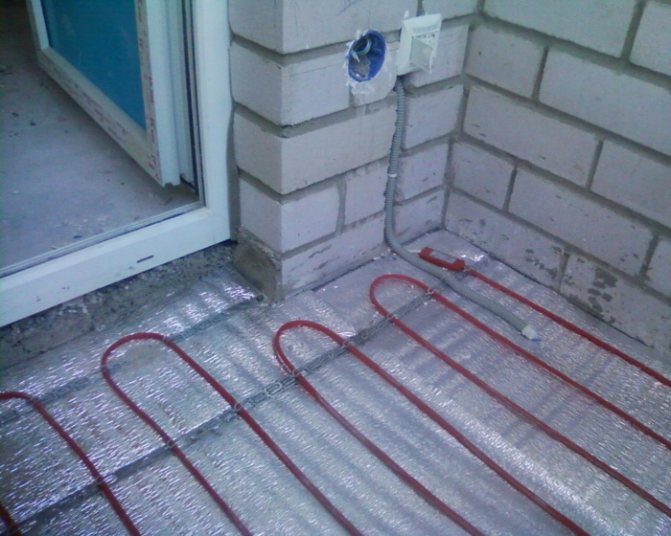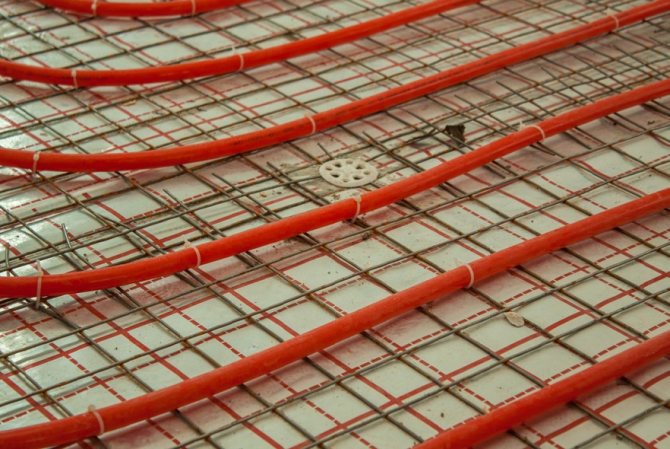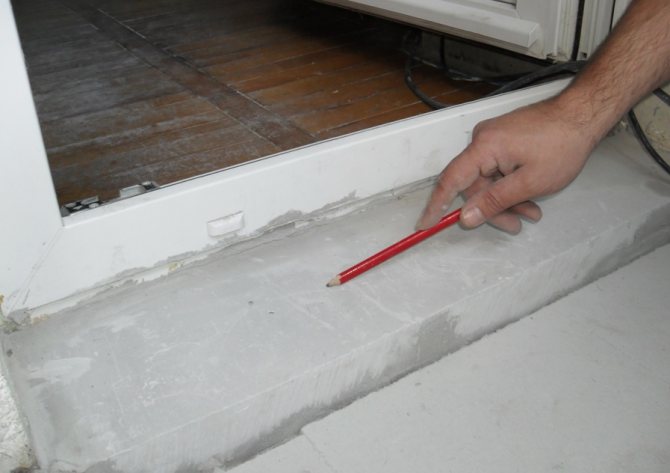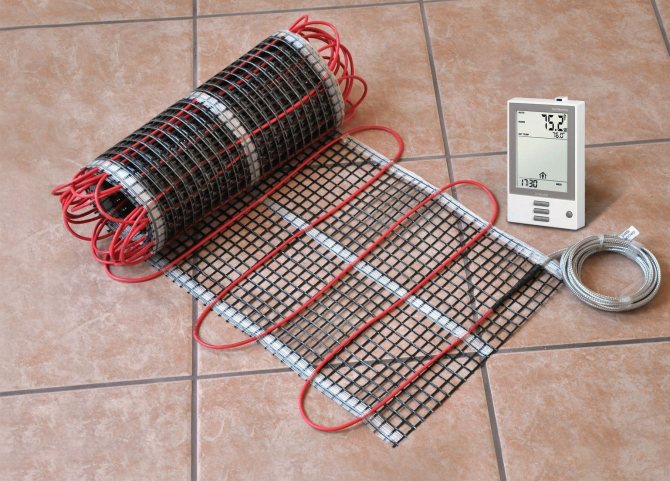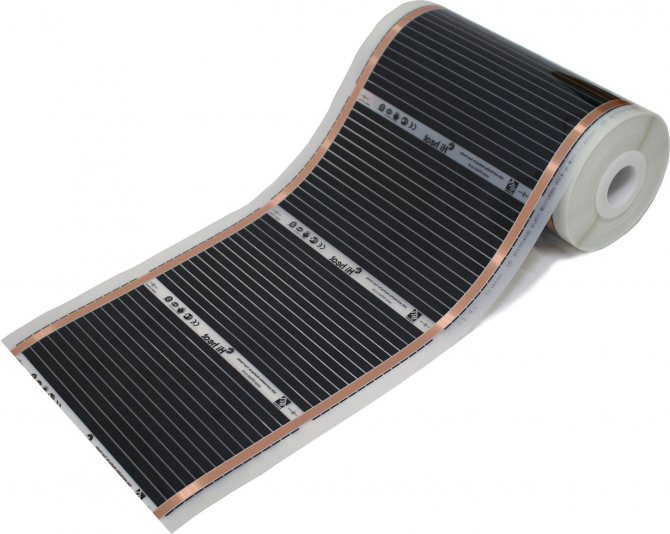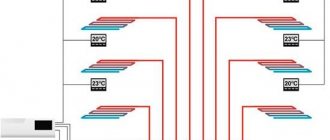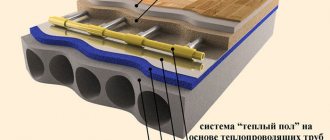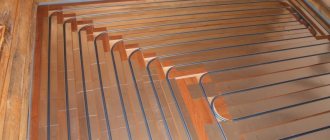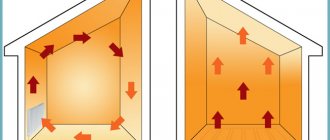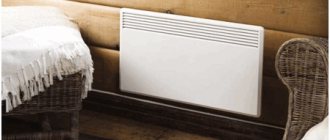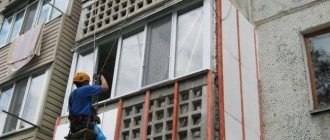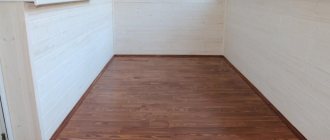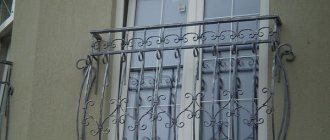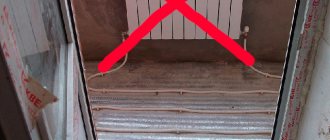An apartment is a home for the vast majority of the population. The limited space forces you to think over not only the layout, but also the situation inside the premises. The idea of rationalizing and optimizing space has led to the fact that a loggia or balcony is often converted into living space. It is for this reason that the warm floor on the balcony has become familiar and even necessary: when planning a balcony, the builders do not consider it a living space, therefore it does not have any heating system.
Pulling pipes from central heating is troublesome and often involves a number of problems. It is for this reason that laying a warm floor on a loggia (or balcony) is often the only way to adapt this space for domestic needs.
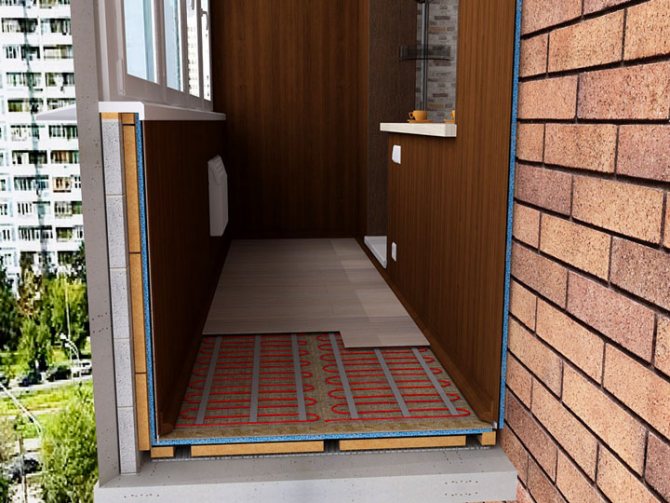
Electric underfloor heating model on a standard balcony
Due to the huge selection of types of underfloor heating, you can choose not only the most effective, but also the most convenient type in terms of installation. This article will consider the insulation of a balcony with a warm floor using various technologies.
Advantages of underfloor heating over classic heating
Radiators and pipes - such a heating system has been actively used for several decades and so far no alternative has been able to completely replace it. Instead of introducing new technologies, the existing systems and radiator devices are being optimized.
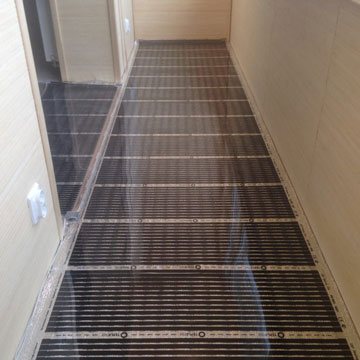

Warm infrared floor on the balcony
However, underfloor heating has become an exception and every year it is gaining ground more and more. One of the reasons is that this type of heating creates temperature conditions that are more pleasant for the human body: heat is supplied from the bottom up, while the main heat remains at the feet.
Heating a loggia with a warm floor is generally almost the only way to effectively and economically warm it up.
Speaking about balconies, the following advantages can be highlighted:
- no need to expand the heating system;
- saving space due to the lack of radiators;
- elimination of the appearance of drafts;
- the emergence of a functional living space.
In addition, a warm floor for a balcony is easier to install, and also much more affordable than the supply of pipes from a central heating system.
The advantages of this type of heating


Underfloor heating technology has many advantages:
- The features of the movement of air masses are taken into account... Thanks to this, the entire volume of air in the room is heated.
- Regulation of the amount of heat generated by such a design.
- This is neutral on the part of fire safety. No electrical wires, sockets. The possibility of using underfloor heating comes with the onset of the heating season.
- Technology is not "afraid" of children or pets, since the materials used in the outer part of the structure are resistant to mechanical stress. Faucets and parts that can be twisted or nibbled are easily removable. The control compartment itself is closed.
- It's profitable. There is no need for any additional costs after connecting the floor heating from the central heating system. Only once - for the purchase of consumables and installation of the unit.
Related article: How to arrange a loggia inside
Balcony water floors
In order to organize a warm floor on a loggia from central heating, you should think carefully about which pipes from which materials will be most appropriate for installing water heated floors.The best option is considered to be pipes made of cross-linked polyethylene or metal-plastic. Their advantages include:
- affordable cost;
- sufficient flexibility;
- durability;
- less risk of leaks.


Cross-linked polyethylene water underfloor heating
Brass pipes, on the other hand, are not the best option for laying a warm floor on a balcony from a battery. They are corrosive, expensive, and the number of joints increases the risk of leaks.
The disadvantages of water floors include:
- Installation of the pump. Such a floor can disrupt the heating system of an apartment building, relieving the pressure in the riser. To correct the situation, you will need to install a pump.
- Uncontrolled temperature. Such a floor is difficult to adjust to a certain temperature.
- Uniform heating. Water tends to gradually cool down, due to which the warm water floor on the balcony can differ in temperature at different points.
In addition, it should be borne in mind that such a floor will significantly eat up the height of the room, and will also require a long preparation stage.
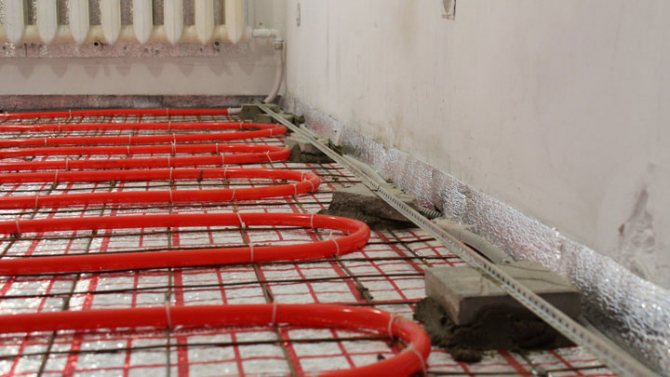

One of the final stages of installing a warm water floor
In the process of the latter, the floors will be leveled, heat and waterproofing materials will be laid. Without them, some of the heat will go to the neighbors below.
Installation of a warm water floor system
This system is quite complex in comparison with any of the electric types of floor heating. It has many different components, such as pipes, a manifold and a box for it, a pump and a thermostatic device.


Connection diagram, collector
The installation process can be divided into the following stages:
- A heat reflector is placed on top of our waterproofing. Thanks to him, the heat will not go down, but will be reflected towards the room.
- Then it is necessary to lay our pipes according to a pre-planned arrangement. It is worth noting that the distance between parallel heating sections should be about ten centimeters. For small rooms such as a balcony, pipes can be laid every fifteen centimeters. This will save you material and energy costs for heating the system.
- The next step is to install the manifold box and the manifold itself. For him, you need to hang your own outlet or connect to the network through a switch. This is necessary to be able to turn off the pump to turn off the floor heating unnecessarily.
- Then the thermostat is connected to the system and a test run is performed. If no leaks are found and the system is working properly, it is necessary to drive it several times.
- The run is carried out in two or three stages, the pressure in the pipes must be accelerated from zero to five bars, and the system must be allowed to work at such a load for about a day.
- After running, the pressure can be reduced to two bar and the screed can be poured. A reinforcing mesh is fixed on top of the pipes and mortar is poured.
Related article: How to process the lining on the loggia
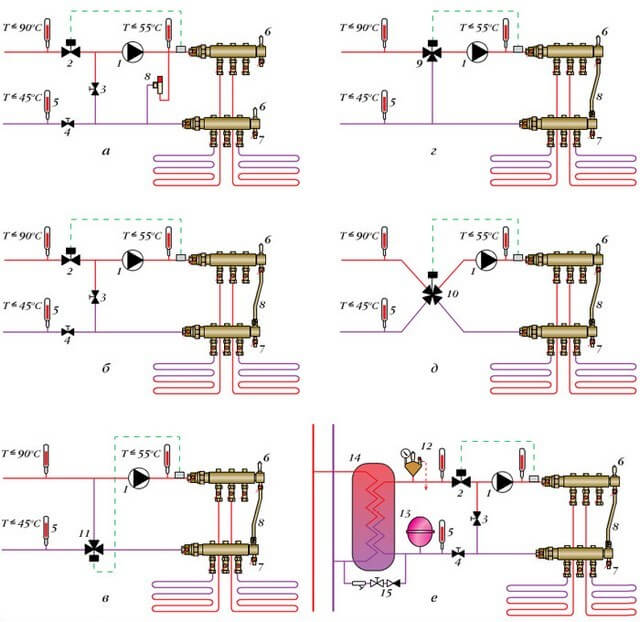

Recommended connection schemes for risers
When filling the screed, the system must operate at a pressure of two bars and at a constant temperature of twenty-eight degrees Celsius. This is necessary so that when the concrete dries, the channels necessary for the pipes are formed in the thickness of the concrete.
The system should work continuously throughout the entire drying period of the concrete screed, approximately thirty to thirty-five days. Then you can turn off the heating, if necessary. The thickness of the screed over the pipes must be at least three centimeters so that it has the proper strength and does not crack during operation.
Installed thermostats can work in two ways. In the first, it will set the temperature of the water in the system, so the overall temperature of the pipes and the room will be slightly lower.The second way is to set the room temperature.
Such thermostats are equipped with a heat sensor, and when the heat level drops by several degrees, the system turns on and begins to catch up with the required temperature. It is best to install such a sensor in the center of an apartment or a heated room.
Electric balcony floor: advantages and disadvantages
Electric underfloor heating on a loggia or balcony is an optimal alternative to water floors. The indisputable advantages of this type include:
- Adjustable temperature. Such a floor is regulated using a special device mounted on the wall. This allows you to set the temperature without reference to the main heating system.
- Occupied space. The electric underfloor heating on the balcony takes only a few centimeters of the room height.
- Ease of installation. Unlike a pipe system, electric cables can be laid even by an inexperienced person.


Electric underfloor heating on the loggia
A significant disadvantage is electricity consumption. This moment must be taken into account when choosing the type of underfloor heating, since it is impossible to reduce this indicator.
The cable laying process itself is not long, but the screed, which is poured over the entire system, should dry for at least a few days.
The exact amount of time depends on the manufacturer.
Electric underfloor heating on the balcony
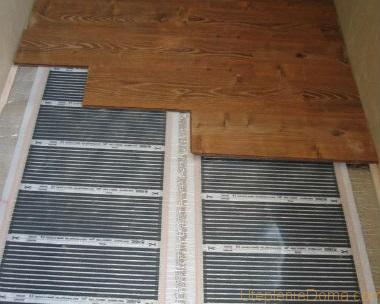

IR films are the cheapest and most dangerous floor heating.
With electric heating, things are a little different. There are no legal restrictions on the installation of such heating in non-residential premises. The following heating element options are available:
- cable in coils;
- fiberglass cable;
- infrared film;
- infrared rod tapes - many connection points, unreliable option, alternative to cable on a grid.
The cable in coils is single-core and two-core. The latter is shielded to minimize the magnetic field. It is covered with very strong insulation, which can only be damaged with a drill or grinder. The thickness of the cable is approximately 5 mm, it is placed in the screed layer, rarely under the wooden floor along the logs. This is a time-tested option, the reliability of which is beyond doubt. Installation is carried out in the same way as for the water circuit, with the exception of installing a temperature sensor between the wires at the place of a 180-degree turn. The distance from the cable to the sensor must be the same on all sides.
A newer type of heating element is a 2.5mm thin cable glued to fiberglass. Such a warm floor is produced in rolls, it can be put in a screed, or it can be directly under the tiles. Such heating is placed where there is no furniture and equipment. The temperature sensor is mounted similarly to a single cable.
Did you know that liquid wall insulation is government approved. The facades are insulated with it, then people file lawsuits in courts, since the money has been spent, but there is no effect.
A profile application is the application of heat-insulating paint to pipes. About this here.
The newest type of electric underfloor heating is infrared films with a thickness of less than 0.5 mm. Their peculiarity is that they are placed directly under the topcoat (laminate or linoleum). At the same time, there are only two advantages of underfloor heating under the laminate on the balcony - they are low price and easy installation. There are much more cons:
- no grounding - only RAM saves from electric shock;
- contact with moisture should not be allowed;
- it is too easy to damage;
- to keep the floor warm, the heating element must always be switched on.
Installation of IR films is carried out on top of a thin layer of insulation made of foamed polyethylene. The effect of such thermal insulation is small, respectively, the heat goes not only up, but also down. Hence the overspending of the energy carrier.
Infrared floor: effective when used on balconies or loggias
In apartments, you can increasingly find infrared floor heating on the balcony. This type is a subspecies of electric floors. Outwardly, it looks like a thin film with black stripes on it. It is the latter that provide heat generation.


Infrared floor heating installation
Unlike their parents, these floors consume significantly less energy, while providing about the same amount of heat.
Such a film warm floor on a loggia or balcony can be characterized by the following features:
- Uncomplicated styling process. Installation of a warm floor on a loggia or balcony does not require special knowledge or skills. In some cases, the infrared floor can be placed directly on the old floor.
- Uniform heating over the entire area. Such a floor will distribute heat evenly.
- Availability. Both the price of the film itself and the electricity bills will be affordable for even the most budget-conscious people.
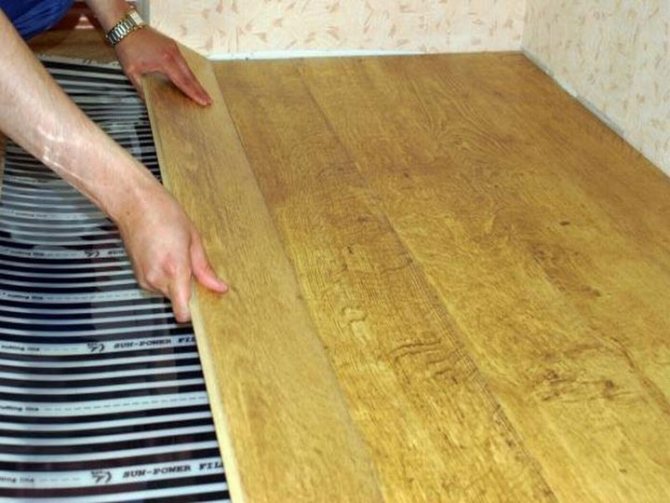

Laying the laminate on top of the infrared floor.
Nevertheless, in order to make a warm floor for a loggia using this technology, you should take into account the location of the furniture in advance. From constant exposure to heat, the latter can quickly deteriorate. In addition, there is always a risk of damaging the heating elements from massive heavy furniture. Overheating may also occur under decorative elements.
Loggia heating options
Heating can be organized in several ways: installing a warm floor, electric or water, and installing infrared or oil radiators. The installation of a battery on the loggia is also used, with a connection to central heating.
Electric underfloor heating
The warm floor on the loggia due to electricity is organized by laying a heating cable or ready-made mats from it. When plugged into the network, the cable heats up to the temperature inserted on the thermostat. After assembly, the warm floor is poured with a layer of cement screed. However, it can be omitted if you plan to use tiles as a finishing floor.
Such a heating system is convenient and safe, but it has several drawbacks. The first is the high energy consumption of underfloor heating. It is about 120 W per 1 m2. The second minus is that the cable can heat up quite strongly (up to 80 degrees), so laminate flooring should not be laid over the warm floor.
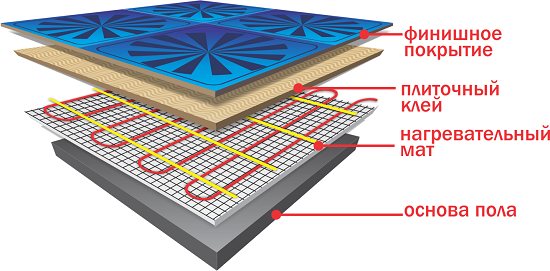

How to heat a loggia or balcony: warm electric floor
Infrared underfloor heating
Another way to heat the balcony and loggia is to install infrared mats. Here, the floor is heated by increasing the temperature of the graphite strips, sealed in a film. At the same time, the maximum temperature of the mats is not at all high - 55 degrees, which makes them safe for any kind of finishing coatings.
Heating the loggia with infrared mats has other advantages:
- High level of security.
- Low power consumption.
- Heating can also be installed on walls and ceilings.
- No need to organize a cement screed over the warm floor.
Please note: heating mats are designed in such a way that damage to an individual element will not affect the operation of the neighboring ones in any way. For comparison: damage to the section of the cable, which was mentioned above, will disable the entire underfloor heating system.
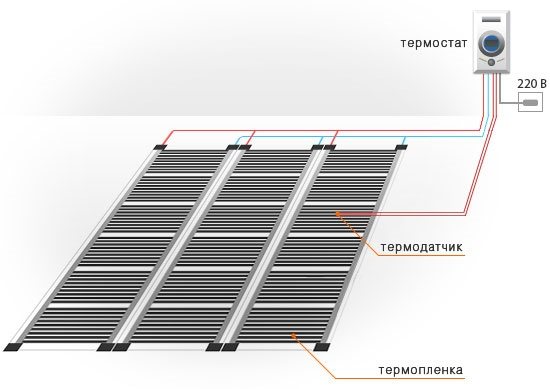

Underfloor heating with infrared mats
Water heating: warm floor
The warm water floor on the loggia works on the principle of an ordinary battery, only the latter is located on the wall and has a compact size. And here the heating pipes are laid on the floor, on special mounting mats. Warm water enters the floor system from the same place where the entire apartment is heated - from central heating or a domestic boiler. The laying and connection of the warm floor can be done by hand, and the payment for heating will not increase significantly.
At the beginning of such work, you will have to obtain permission in the same way as if you carried out the transfer of the battery to the loggia, which we will talk about in the next section of the article. By the way, when deciding on installation, it must be borne in mind that pipes filled with water, coupled with a cement screed that covers them, weigh a lot.
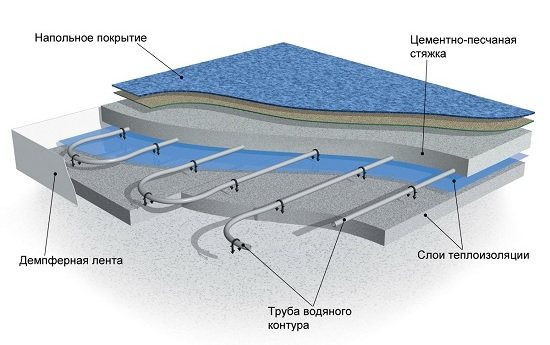

Water heat-insulated floor on the loggia. This heating option has good reviews.
All kinds of electrical appliances
If heating the loggia is required only periodically, then it is best to use electrical appliances, portable and stationary:
- Oil radiators and convectors. Small rooms warm up well, but not too quickly.
- Heat guns. They should be used with caution for heating, as the device "burns" oxygen.
- Infrared heaters and fireplaces. Very economical in energy consumption. They can be floor, wall and ceiling.
Please note: infrared batteries have a small heat transfer radius. This feature must be taken into account when choosing a place for installing the heater. That is, if an office is equipped on the loggia, then we install heating above or next to the workplace.
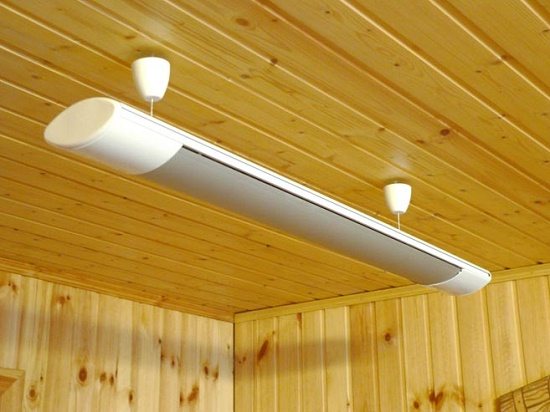

Infrared heater for loggia
Warm floors and various floor coverings
The balcony, like any other room, can be decorated by the owners in a variety of ways based on their preferences and tastes.
However, in order to make it not only beautiful, but also comfortable for use, one should delve into the problem of compatibility of certain types of flooring and various types of warm floors in advance.
After the installation of the warm floor on the balcony or loggia is completed, it is time to lay the final decorative flooring. Most often, in such cases (for balconies and loggias), a variety of tiles or linoleum are used.
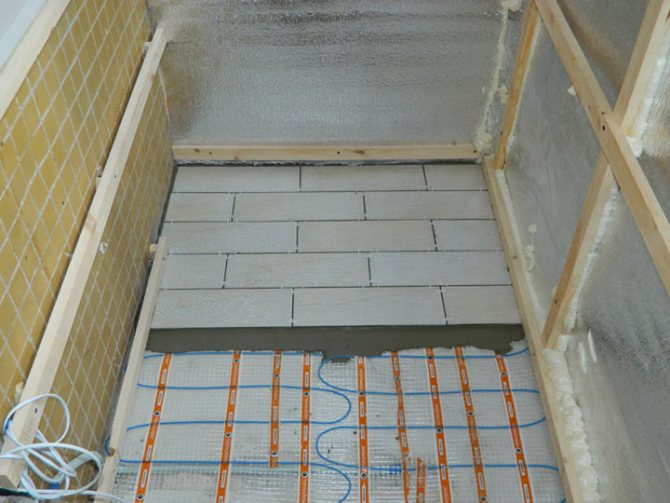

Using tiles as flooring on a loggia
The tile is perfect for any underfloor heating system, as it tolerates high temperatures perfectly. In addition, it has excellent thermal conductivity, which allows the heat to warm up the area faster.
It is also possible to lay a warm floor on the balcony under linoleum, however, it is important to take into account the properties of the particular coating chosen. Some people easily tolerate temperature changes, while others are contraindicated. That is why it is undesirable to combine water and infrared systems with linoleum.
Often, in the areas of loggias and balconies, there are laminate and carpet. The warm floor on the balcony under the laminate is easy to install, and the material itself is a little whimsical: modern models can withstand high temperatures, as well as tolerate their changes without compromising their properties or appearance.
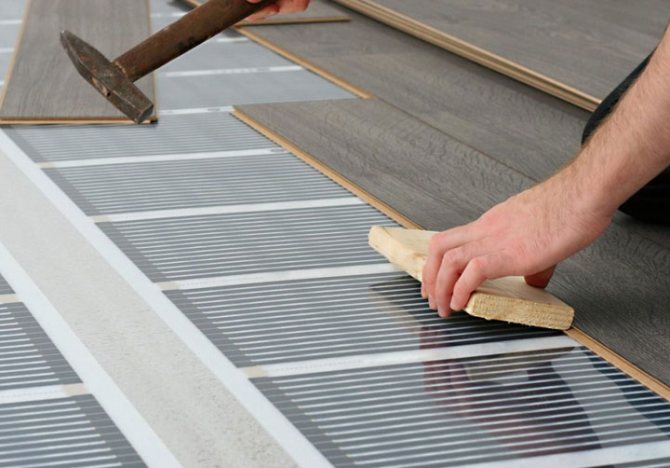

Using laminate flooring
Carpet allows you to add coziness and warmth to even the coldest balcony, however, when using this covering, keep in mind the following:
- it should not be made of toxic, fusible materials;
- the covering under the furniture will be exposed to more heat;
- it is not recommended to choose material with a long pile.
Before choosing a warm floor for a balcony, you need to think in advance about what restrictions the selected type of heating will impose on the choice of flooring.
Insulation of the loggia and warm floor - a description of the installation process
- To begin with, it is necessary to calculate the size of the heated area, since in case of an error, a decrease in the pitch of the cable to be laid will be required, which is by no means recommended to be done.
- After that, it is necessary to start preparing the working surface, after which a layer of thermal insulation with a thickness of at least 50 mm is laid on the floor.
- A metal mounting tape is installed on top, then a heating cable is laid on it, observing a certain distance.
- Then a thermostat is placed on one of the walls, which controls the correct operation of the device. A special cable and a thermal sensor are connected to it.
- Then it is necessary to install the floor screed, the thickness of which should be in the range of 30-40 mm. To carry out these works, the base with the installed structure is poured with concrete.
- After the screed is prepared, the floor covering is laid on it.
What you need to know about installing a warm floor?
Before proceeding with the installation, you should study and think over the following points:
- the presence of heat and waterproofing;
- location diagram;
- the possibility of installing such a system in an apartment.
The first point is important, since due to its observance, heat losses will be reduced, and neighbors from below will not be threatened by a constantly warm ceiling.
The device of a warm floor on the balcony also includes thinking over the layout of pipes or cables. There are three types in total:
- snail;
- snake;
- double snake.
The choice of styling is based on the shape of the room, however, in rectangular spaces, an ordinary snake is most often used.
Before starting work, you should find out whether it is possible to install a warm floor (if we are talking about water) and whether the balcony slab will withstand an additional layer of screed. This prudence will eliminate the risks of emergencies.
DIY floor heating installation
The installation of underfloor heating on the balcony should be carried out exclusively by craftsmen in the case of a water field. In this case, a number of actions are taken to level the surface, work out the scheme of pipe systems, lay them and connect all the equipment necessary for the correct functioning of the equipment. It is impossible to cope with such work without experience and at the same time get a satisfying result.
The situation is completely different with the family of electrical heating systems. Heating a balcony with a warm floor based on an electric cable is a fairly quick and convenient way. To install it, you do not need any special knowledge, and you can use the services of a field specialist to connect to the electrical network. In fact, the cable is simply laid according to a certain scheme chosen according to the situation and is attached to the base of the floor. After that, the entire system is poured with a screed, which must dry for the time specified by the manufacturer. Before the expiration date, it is strictly forbidden to turn on the system.
The infrared floor is so easy to install that even an inexperienced person can easily cope with it. Detailed instructions on how to install a warm floor are supplied with the film itself. Infrared floor heating can often be placed on top of old flooring. The main thing is to take care of sufficient heat and waterproofing.



